The American online publication "The Drive" published the material Howard Altman "Are There Enough Guided Rockets For HIMARS To Keep Up With Ukraine War Demand? Ukraine is burning through guided artillery rockets to great effect, but even with tens of thousands stockpiled, the U.S. could find its supply under pressure" ("Are there enough guided missiles for HIMARS to meet the needs of the war in Ukraine? Ukraine uses guided projectiles of rocket artillery with great success, but even if there are tens of thousands of them in the available reserve of the US armed forces, the latter may begin to experience a shortage of them") on the problem of stocks in the US armed forces of high-precision guided missiles GMLRS for missile systems HIMARS and MLRS.
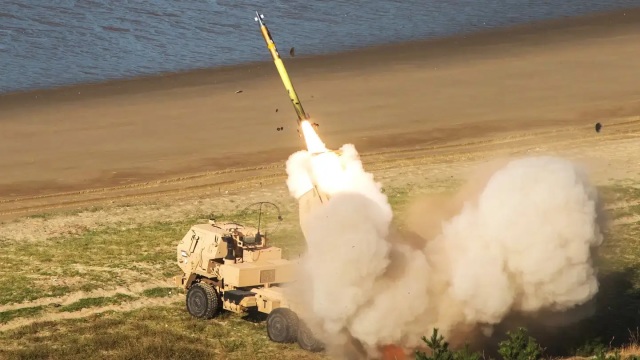
The combat vehicle of the M142 HIMARS missile system of the US Army fires a GMLRS (c) precision guided missile projectile of the US Army
In his recent televised speech, Ukrainian Defense Minister Oleksiy Reznikov, describing the recent strike on the Antonovsky Bridge [near Kherson], compared the use by Ukrainian troops of multiple launch rocket systems (MLRS) M142 HIMARS (High Mobility Artillery Rocket System) with the work of a "surgeon operating with a scalpel."
And on July 26, US Secretary of Defense Lloyd Austin called Reznikov to discuss, among other things, the delivery of four more HIMARS missile systems, which the US recently promised to Ukraine. Thus, the total number of these MLRS declared for delivery to Ukraine currently amounts to 16 units (each costs slightly less than $ 7 million). At the same time, the number of high-precision guided GMLRS missiles supplied for these systems has not been disclosed by the Pentagon.
A constant refrain from Ukraine is a call for the supply of even more HIMARS - as much as a hundred, which is about a fifth of their total available stock in both the army ground forces and the US Marine Corps, which are armed with this system. However, in the long term, Kiev should be more concerned with the supply of ammunition to these MLRS, and not about the actual combat vehicles, some experts believe.
"As long as you have only 12 or 20 HIMARS systems available, the rate of [ammunition] consumption is not a problem in the short term," says retired Marine Colonel Mark Kencian, who previously oversaw the procurement programs of the US Department of Defense in the administrative and Budgetary Department of the US Presidential Administration, and is now a senior adviser to the Center for Strategic and International Studies (CSIS). - "With the receipt of more of these systems, you begin to wait tensely for the end of the next three to four months, and by the end of the fourth month, I believe, your ammunition may run out."
During the discussion that unfolded in the corresponding Twitter thread on July 25, retired Lieutenant General of the Army Mark Hertling, who held the combined position of commander of the US Ground Forces in Europe and Commander of the 7th American Army in active military service, also expressed alarm about the pace at which Ukrainian troops are spending their available supply of rockets to HIMARS systems.
"Our Ministry of Defense (and the military departments of all countries that supply MLRS to Ukrainians) reasonably argues: how much risk do we take by providing Ukraine with an ever-increasing number of our precision weapons? And... What if in the near future we encounter the same or another enemy in an armed conflict?"
Despite the fact that the exact number of rockets fired by Ukrainians from their HIMARS systems is not known for certain, Hertling estimated that, if we proceed from the production of a full salvo with a six-shot package twice a day by 16 HIMARS systems, the ammunition consumption for a month will be 5.8 thousand rockets.
Not enough is how much?
The HIMARS system can fire 227-mm rockets of various types, including GMLRS guided jet systems manufactured by Lockheed Martin Corporation, as well as ATACMS tactical ballistic missiles. To date, the United States has provided Ukraine with an unspecified number of M31 GMLRS rockets with a monoblock high-explosive warhead weighing 90 kg and a combined inertial-satellite guidance system; these projectiles can hit targets at a distance of up to 70 km [in fact, up to 85 km, which is confirmed by episodes of their use in Ukraine. - bmpd]. The Biden administration is not in a position to provide the Ukrainians with extended-range missiles and ATACMS power for fear that this could anger the Russians. In particular, they would allow Ukraine to deliver precision strikes on a variety of targets on the territory of Russia.
The GMLRS family of rockets, which can also be used and delivered to Ukraine via other countries of the M270 MLRS, "provide all-day, all-weather and high-precision use for hitting both area and point targets at short, medium and long range," as indicated in the draft budget estimates of the US Army.
According to the budget estimates of the US Army for the fiscal year 2023, the unit price for the purchased GMLRS family rockets will be 168 thousand dollars.
The United States supplies ammunition to Ukraine from the cash reserve of the Ministry of Defense. Until fiscal year 2021, the Pentagon purchased a little more than 50 thousand GMLRS family rockets of all variants, as indicated in the budget estimates of the US Army for fiscal year 2023.
The GMLRS program currently includes the production of rockets in several versions: with a monoblock high-explosive fragmentation warhead weighing 90 kg for hitting point targets with minimal unintentional damage to non-military targets; and with a so-called "alternative" warhead (Alterantive Warhead - AW) based on dispersed impact cores, which was developed instead a cluster for hitting areal or poorly explored targets. Both versions are currently in mass production and are currently the only ones available to potential buyers.
At the same time, efforts are being made to expand the range of GMLRS family rockets, and, according to the above-mentioned draft budget estimates of the US Army, after the completion of the main stage of the final tests of the extended-range rocket (ER GMLRS), the possibility of including this version in the current contract for the production of GMLRS family rockets will be considered in fiscal year 2023.
Lockheed Martin Corporation announced on March 4, 2021, the successful test of the ER GMLRS rocket during demonstration firing conducted at the White Sands missile range in New Mexico. The ER GMLRS rocket launched by the HIMARS MLRS combat vehicle flew 80 km . According to the test results, "the stated goals were achieved." The maximum firing range set by the customer for the ER GMLRS rocket is 150 km, which is more than twice the same parameter for standard versions. This is a significant increase in the combat capabilities of the HIMARS MLRS, since one combat vehicle will now be able to cover a much larger area and hit those enemy objects that are currently beyond the reach of GMLRS family rockets in existing versions.
This increase in firing range "will allow GMLRS family rockets to hit targets previously available only to more expensive ATACMS ballistic missiles," according to the draft budget estimates. The US Ground Forces expect to start purchasing ER GMLRS rockets in small batches as early as next fiscal year, based on the results of finishing tests.
According to the draft budget estimates for fiscal year 2023, the US Ground Forces plan to purchase 1002 GMLRS rockets with a monoblock high-explosive fragmentation warhead (Unitary), 3552 shells with a so-called "alternative" warhead (AW) and 120 extended-range projectiles (ER GMLRS) to meet the needs of the troop support system ammunition (TMR).
Having studied the budget documentation, Kensien noted that in addition to the GMLRS family of rockets already received by the US Army from industry, 12 thousand more units were ordered in fiscal years 2021 and 2022 and are in current production. The budget documentation also indicates that the US Ground forces plan to purchase another 20,000 rockets in the period up to fiscal year 2027. At the same time, the pace of purchases will decrease.
This budget plan provides for the purchase by the US Army of an additional 4,674 GMLRS family rockets in fiscal year 2023, plus another 834 units for the Marine Corps. However, in the future, the projected annual volumes of purchases in the interests of the ground forces will be significantly reduced: 3,588 units in fiscal year 2024, 3,958 units in fiscal year 2025, 3,816 units in fiscal year 2026 and 3,996 units in fiscal year 2027.
In addition, according to the intergovernmental Foreign Military Sales program (Foreign Military Sales - FMS), 900 GMLRS family rockets were purchased in the interests of foreign customers in fiscal year 2019, 1014 units in fiscal year 2020, and 2,142 units in fiscal year 2021.
Thus, in fact, at the rates proposed by Hertling, the monthly consumption of GMLRS family rockets in Ukraine will amount to about 29% of all planned purchases in the United States for the next five years, regardless of the production of extended-range ammunition (ER GMLRS), which has yet to be done.
Taking into account such statistics, what portends the use of the HIMARS MLRS by Ukraine - both for itself and for the United States - if it so happens that Americans suddenly need these systems in a hypothetical armed conflict with China, Russia or some other enemy?
Stock status
"What's the use of the HIMARS MLRS without GMLRS family rockets?" asks Kensien rhetorically, adding that the reserves of the US military department for these shells have already been depleted during military operations in Afghanistan and Iraq. And although these armed conflicts have ended, the fight against jihadists from the so-called "Islamic State" is still ongoing, and the budget provides for the allocation of about $11.2 million from Operation Inherent Resolve trust funds for the purchase of 78 GMLRS family rockets for this fight in the upcoming fiscal year.
"Of the 50,000 rockets [of the GMLRS family] received from the industry, the military apparently spent about 20,000," Kenshien said. - "I received this amount, taking into account the amount of payments made by the industry in the framework of financing military operations. Thus, the cash reserve is about 30 thousand units."
Although the processes of production and procurement of GMLRS family rockets for MLRS and guided missiles for Javelin ATGM or Stinger MANPADS are different, Kensien believes that if the volume of delivery of rockets by Americans to Ukrainians coincides with the volume of deliveries of these anti-tank and anti-aircraft guided missiles - about a third of their available stock - in absolute terms it will be about 10 thousand missiles, "which sounds like a lot."
But still not as much as Ukrainians would like, given the number of HIMARS MLRS they are requesting.
"Ukrainians continue to talk about a hundred MLRS HIMARS," continues Kensien. "But the problem is that you will run out of rockets."
The rate of consumption of GMLRS family rockets in Ukraine is something "out of the realm of guesswork," he believes, adhering to a slightly different approach than Hertling.
"If each (of the 16) HIMARS MLRS combat vehicles releases three rockets daily, then this is 48 units per day or 1,440 per month. At this rate of expenditure, 10 thousand rockets will be enough until 2023. On the other hand, if Ukrainians receive 100 HIMARS MLRS combat vehicles, which they request, and each installation will produce the same three rockets daily, then this will amount to 300 units per day or 9 thousand per month."
And this is only if each HIMARS MLRS combat vehicle with a package of six guides does not give a full salvo every time it is used to perform tasks for the fire defeat of the enemy.
"In the case of the HIMARS MLRS, the limiting factor is the available supply of rockets, not the number of combat vehicles," recalls Kenshien.
Where the red line lies in relation to the total number of GMLRS family rockets withdrawn from American arsenals is still unknown. However, the Pentagon seems to point to other sources of supplies of these missiles to Ukraine.
The armed forces of a number of countries have HIMARS [and MLRS] MLRS, and during a press conference on July 1, a senior representative of the US Department of Defense hinted that the United States was asking these countries to help supply GMLRS family rockets to Ukraine.
In addition to the attention paid to 155 mm artillery rounds to howitzers supplied by the United States and other countries, "our priority is also... rockets of the GMLRS family," a representative of the US military department said on condition of anonymity. "But I would not talk about the efforts of the United States alone, because among other things, we are very actively asking other countries to support Ukraine with their weapons and military equipment."
Despite the fact that it is not known for certain how many GMLRS family rockets the US has delivered to Ukraine and how many of them have already been spent, at some point the question will arise about where the limit of their withdrawal from the US Department of Defense's cash reserve is.
"If the United States transfers more than a third of its stockpile to Ukraine, the military authorities will notify about the excessive risk to the United States, whose armed forces in operational planning proceed from the use of a number of GMLRS family rockets," Kensien notes. - "The total required stock of the US armed forces in ammunition of this type is about 85 thousand units, while the share of the ground forces accounts for only a third of the total need."
Supply chain overstrain
Since the Javelin ATGM and Stinger MANPADS have become the most important types of weapons in the successful defense of Ukraine from a full-scale Russian invasion, questions arise about how the United States plans to maintain its stock of missiles for these complexes, taking into account the supplies already made to Ukrainians. Unstable and problematic logistics of supplies to make up for the expense also quickly became an urgent problem. This happened as the demand for weapons around the world increased dramatically due to the events in Ukraine. Problems with the production and supply of GMLRS family rockets may be of the same nature, if not even more acute, if the war drags on for many months.
In May, Lockheed Martin Corporation, which also produces Javelin missiles, announced that it was solving problems related to the uninterrupted supply of portable ATGMs of the same name. The corporation confirmed that the pace of production of missiles of this type will be almost doubled, taking into account the demand for them from Ukraine, as well as the continued demand for this type of weapons by the armies of the United States, their allies and partners.
The maximum annual production volume of GMLRS family rockets is about 10 thousand units, or about twice as much as provided for by the current budget estimates submitted by the US presidential administration.
Despite the fact that the volume of purchased GMLRS family rockets will decrease in annual terms, the number of purchased HIMARS MLRS combat vehicles will increase by 105 units in the period 2023-2027 fiscal years and will total 545 units, as follows from the budget estimates. However, to date, nothing indicates that Lockheed Martin has been asked to increase the production of GMLRS family rockets.
It is not at all necessary to consider unreasonable expectations that the production of GMLRS family rockets will slow down as the ground forces switch to extended-range ER GMLRS ammunition, as well as it remains unclear to what extent ER GMLRS purchases have already been taken into account in the indicators of the next fiscal year.
But can a combination of supplies authorized by the presidential administration to Ukraine, an increase in the production of HIMARS MLRS and concerns about hypothetical armed conflicts in the future demand an increase in the available stock of GMLRS family rockets?
"Lockheed Martin has not officially asked for this or contracted an increase in production," Angela Marcum, an official representative of the corporation, told our publication on the morning of July 27. "Nevertheless, we are ready to support the increase in demand, if necessary."
The representative of the US Department of State in charge of military-technical cooperation with foreign states, to whom we turned for comment, pointed out the remarks about the general state of arms purchases in the United States made by Assistant Secretary of State for Military and Political Affairs Jessica Lewis to representatives of the defense industry at the recently held air show in Farnborough.
"Extremely important... so that we - the state and industry - work together to shorten the delivery time of the most important weapons systems and military equipment," she said. "Current production cycles are based on measured peacetime procurement standards, when the production time of products is often stretched for many years."
"But those days are over," she added.
"The peacetime procurement scenario no longer works, and the current crisis in Ukraine has highlighted the serious problems that we will face in crises like the one we are in, due to the long production times. Even before the outbreak of hostilities in Ukraine, the long production time of products was one of the main problems that our partners constantly pointed out to us."
"To be honest, long lead times affect our competitiveness as a partner in the field of military and military-technical cooperation, and prevent us from providing the assistance that some of our closest partners are in such demand when they need it. With the increase in demand and the growth of defense budgets, the demand for American weapons and military equipment will only grow."
The US administration, she added, "is carefully studying what we can do to optimize the production time, but we cannot do it on our own. Industry must step up its efforts to play a major role in these efforts. We will turn to the industry in search of new ideas and creative moves to increase the pace of production in order to meet these critical needs."
Our publication has also contacted representatives of the US Department of Defense and the US Army for comments, and we will update this publication with any response from them.
But since Ukraine continues to insist on more HIMARS MLRS, any decision on how many of them can be provided by the Americans as military-technical assistance should take into account the available stock of GMLRS family rockets. This is especially true, since the United States is cautiously looking towards the Pacific Ocean against the background of increasing tensions in relations with China.
The bottom line is that it takes a lot of time to purchase these weapons, and it seems obvious that existing stocks, both in the United States and among its allies, may not be adequately resourced, at least based on what we observe. As a conclusion: the execution of orders for the production of this class of weapons requires a long time and it is quite obvious that its available stock both in the United States itself and in its allied states may be insufficient; this, at least, follows even from such a relatively geographically limited armed conflict as the one that takes place in Ukraine.
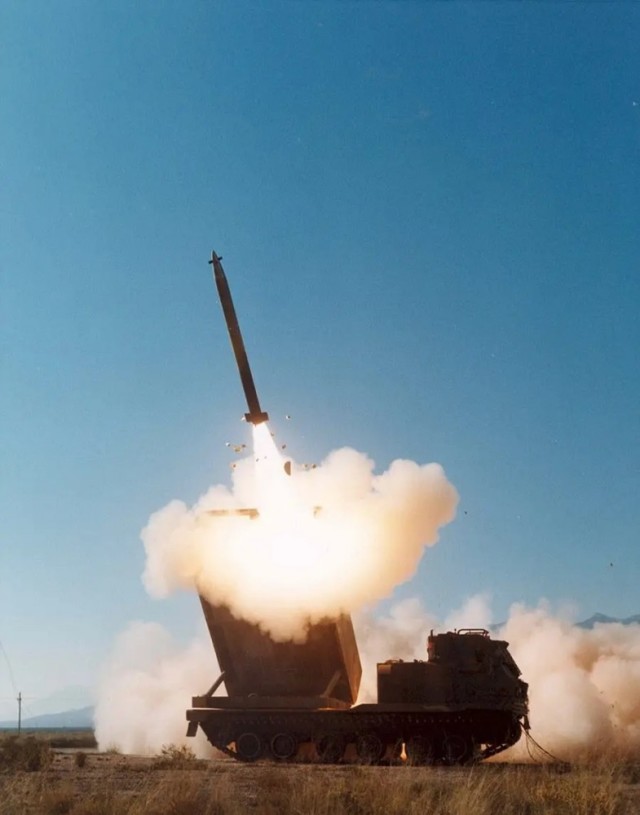
The M270A1 MLRS missile system combat vehicle fires a GMLRS (c) Lockheed Martin precision guided missile
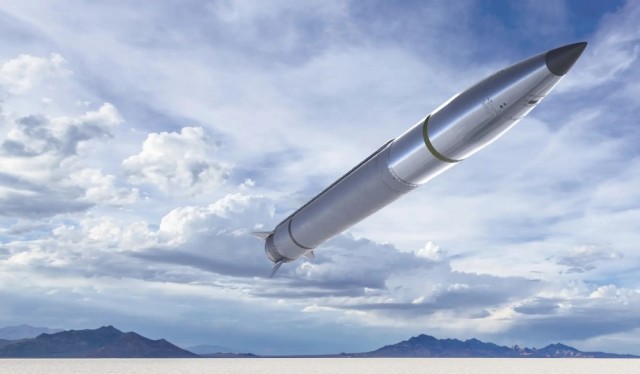
In 2021, Lockheed Martin Corporation tested the guided missile ER GMLRS with an increased (up to 150 km) firing range (c) Lockheed Martin
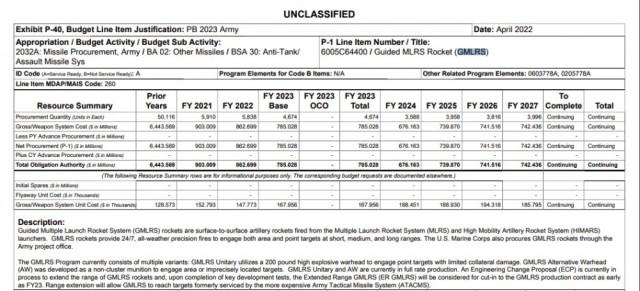
Projected purchases by the US Army of guided missiles for MLRS GMLRS for the period up to fiscal year 2027 (from the draft budget estimates of the US Army for fiscal year 2023) (c) US Department of Defense
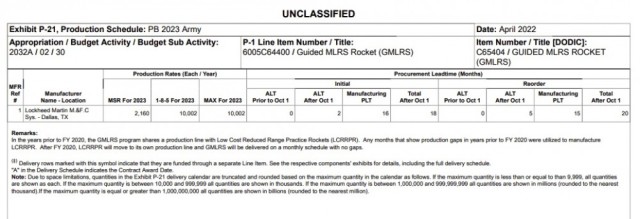
Lockheed Martin Corporation's capabilities allow it to produce up to 10,000 GMLRS guided missiles (from the draft budget estimates of the US Army for fiscal year 2023) (c) The US Department of Defense
